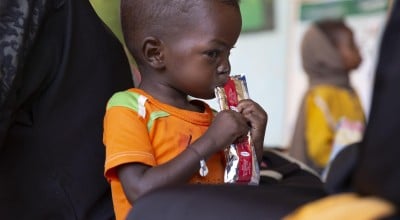
Read our 2024 annual report

Knowledge Hub
World is shamefully falling into a perpetual hunger crisis - says Concern CEO
A country with almost the same population as Ireland has the world’s most alarming hunger problems - according to a new report highlighting massive food inequality around the globe.

- Country with the same population as Ireland bottom of new Global Hunger Index
- Top ten countries with highest levels of hunger revealed including Yemen
- Famine, conflict and inequality reversing progress made in reducing hunger
- Concern CEO says ‘no child should go to bed hungry’
The Central African Republic, which has a population of 4.6 million, has the highest hunger levels out of 119 countries where data could be collected for the 2017 Global Hunger Index (GHI) launched today.
The report highlights the conflict-troubled African nation, where around half its citizens are undernourished, as being the sole country in the GHI’s most severe category of “extremely alarming” - a level no country has fallen to since 2014.
A shocking 51 other countries are ranked as having “serious” or “alarming” hunger according to the study - jointly released today by Concern Worldwide, German aid agency Welthungerhilfe and the International Food Policy Research Institute (IFPRI) - in a year when famine cast a shadow over four nations where over 20 million people are still at risk of starvation.
Worryingly, a lack of data meant 13 countries were not included in this year’s GHI, despite significant concerns being raised about nine of them, including war-torn South Sudan, where famine was declared by the United Nations (UN) in February.
Somalia, another country with insufficient information for the list, was also at risk of famine this year.
Ongoing conflicts in many of these countries, including Syria, were a key factor that inhibited the collection of data necessary for calculating GHI scores.
The report also includes a stark warning that despite the global hunger dropping by 27 per cent in the last 15 years, the United Nations looks likely to fail in reaching the target it set in 2015 to have hunger eradicated by 2030.
“Shamefully, large parts of the world are falling deeper into a perpetual food crisis, despite wealthy nations having the resources, knowledge and technology to reverse this course,” said Concern Worldwide Chief Executive, Dominic MacSorley, whose organisation works in seven of the ten countries highlighted in the GHI with the highest levels of hunger.
Inequality, conflict and climate related shocks are at the heart of this problem, which I witnessed first-hand this year in countries like Central African Republic where our staff work under very challenging conditions to help people struggling to survive.
We tend to talk about hunger in terms of data, percentages, but once you see a child dying of hunger it compels you to act and to do more. It is an obscenity and tragedy in particular because it is preventable.
Ireland continues to play a key leadership role in tackling hunger in the most challenging counties but the world needs to act now as one community with the shared goal of ensuring not a single child goes to bed hungry each night and that no-one is left behind.”
The 2017 GHI is launched just weeks after new data from the Food and Agriculture Organisation of the United Nations revealed the number of undernourished people in the world increased in 2016 by 38 million to 815 million.
While this year’s GHI shows slight overall reductions in children suffering from hunger, it is estimated that 52 million children under five-years-of-age have extremely low weight for their height and 155 million are stunted or have low height for their age due to hunger.
It is also estimated that around 45 per cent of deaths among children under five-years-of-age are linked to undernutrition.
The report states that groups with the least social, economic or political power suffer the most from poverty and hunger - and it makes a number of recommendations to reverse this inequality.
The GHI’s authors call for governments to invest more in achieving the UN's sustainable development goal of zero hunger by 2030, to better support small farmers and include them in policy debates and to ensure fairer standards in business and trade.
The 2017 GHI can be found on www.globalhungerindex.org.
For more information or interview requests please contact Kevin Jenkinson on 086 358 2886 or kevin.jenkinson@concern.net.
Some key findings from GHI 2017
- Hunger levels fell by 27 per cent since 2000
- One country (Central African Republic) fell into the “extremely alarming” category
- 52 out of 119 countries have serious, alarming or extremely alarming hunger levels
- 27.8 per cent of children under five have a height too low for their age, known as stunting, which is down from 37.7 per cent in 2000
- 9.5 per cent of children under five weigh too low for their height, known as wasting, which is down from 9.9 per cent in 2000.
- Roughly half of the populations of Central African Republic, Haiti and Zambia are undernourished-the highest in the report.
- In South Sudan, Djibouti, India and Sri Lanka, one-fifth to one quarter of the children under five weigh too little for their height due to nutritional deficiencies.
- Inequality needs to be addressed if the world is to reach zero hunger goal by 2030.

Other ways to help
Corporate support
Is your company interested in working together for a common cause?
Fundraise for Concern
From mountain trekking to marathon running, cake sales to table quizzes, there are lots of ways you can support our work.
Buy a gift
With an extensive range of alternative gifts, we have something to suit everybody.
Leave a gift in your will
Leave the world a better place with a life-changing legacy.
Volunteer with Concern
The lots of ways to get involved with our work as a volunteer
School fundraising
Without the generous support from schools, we wouldn't be able to do the work that we do.




